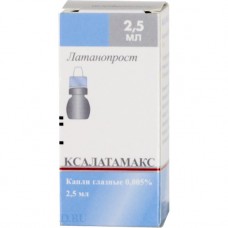Expiration date: 03/2026
Clinico-pharmacological group
Anti- glaucoma drug
Release form, composition and packaging
Eye drops 0.005% transparent, colorless.
1 ml contains:
latanoprost 50 mcg
Excipients: benzalkonium chloride 200 mcg, sodium dihydrogen phosphate monohydrate - 4.6 mg, sodium phosphate - 4.74 mg, sodium chloride 4.1 mg, purified water - 996.31 mg.
2.5 ml plastic bottles with dosing pipette (1) - packs of cardboard.
2.5 ml plastic bottles with dosing pipette (3) - packs cardboard.
Pharmacological action
Anti-glaucoma the drug for local use. Latanoprost is a prostaglandin analogue F2?? a selective agonist of the FP receptor. Reduces intraocular pressure by increasing the outflow of aqueous humor and provides protivoglaucomnoe action. The primary mechanism of action latanoprost associated with increased uveoscleral outflow. No significant effect on products watery moisture and does not affect the hemato-ophthalmic barrier.Reduction of intraocular pressure begins 3-4 hours after drug administration, the maximum effect observed after 8-12 hours, the duration of at least 24 h.
Pharmacokinetics
Suction
Penetrates well into the cornea, thus there is latanoprost hydrolysis to the biologically active form - acid latanoprosta. Cmax latanoprosta in watery moisture is approximately 2 h after local application of the drug.
The eye tissues latanoprost acid is practically not metabolized; metabolism occurs mainly in the liver.
Metabolism and excretion
T1/2 is 17 min. Major metabolites, 1,2-dinor - and 1,2,3,4-tetranor-metabolites have no or weak biological activity, are excreted by the kidneys.
Testimony
- open angle glaucoma;
- increased intraocular pressure.
Contraindications
- age of 18 years;
- hypersensitivity to latanoprost, benzalkonium chloride or other ingredients of the drug.
Caution should be used in patients with aphakia, pseudophakia, damage to the posterior lens capsule and other risk factors for macular edema (when treating latanoprost described cases of macular edema, including cystoidea), inflammatory, congenital glaucoma due to the lack of sufficient experience with the drug.
Dosage
The drug is instilled into the conjunctival SAC of the eye 1 drop of 1 times/day, in the evening. When skipping doses next dose is administered in normal mode (i.e. dose double). With more frequent administration of the drug its effectiveness is reduced. The duration of treatment and the possibility of recurrence be determined by your doctor.
Overdose
Symptoms: irritation of eyes, redness of the conjunctiva or episclera.
Treatment: symptomatic therapy.
Drug interactions
Latanoprost has an additive effect on lowering intraocular pressure when applied in combination with beta-blockers, adrenergic agonists, carbonic anhydrase inhibitors and partial additive effect when used in combination with m-cholinomimetics.
In vitro studies revealed that when mixed with latanoprost eye drops containing thiomersal, is precipitation. Therefore, eye drops containing these substances, should be used with interval of at least 5 min.
The simultaneous use of 2 analogues of prostaglandins can cause a paradoxical increase in intraocular pressure.
Pregnancy and lactation
Sufficient experience in use of the drug during pregnancy and lactation no. Primeministers when pregnancy is possible only under the supervision of a physician and only if the expected benefit to the mother outweighs the risk of possible side effects in the fetus.
Latanoprost and its metabolites can be transferred with breast milk. If necessary, the appointment Xalatlaco during lactation breastfeeding should be discontinued.
Side effects
On the part of the organ of vision: eye irritation (burning sensation, feeling of sand in eyes, itching, stinging and foreign body sensation), blepharitis, conjunctival hyperemia, eye pain, increased pigmentation of the iris, transient point of erosion of epithelium, swelling of the eyelids, swelling and corneal erosion, conjunctivitis, lengthening, thickening, increased numbers and increased pigmentation of eyelashes and downy hair, iritis/uveitis, keratitis, macular edema (including custody), changing the direction of eyelash growth, sometimes causes eye irritation, blurred vision.
Dermatological reactions: rash, darkening of the eyelid skin and local skin reactions on the part of the eyelids.
From the nervous system: dizziness, headache.
The respiratory system: bronchial asthma (including acute attacks or exacerbation of the disease in patients with bronchial asthma in history), shortness of breath.
From the side of musculoskeletal system: muscle pain, joint pain.
Other: nonspecific chest pain.
Terms and conditions storage
The drug should be stored out of reach of children, dry, dark place at a temperature of 2 to 8°C. shelf Life - 2 years.
Open the vial should be stored at temperature not exceeding 25°C. After opening the bottle the drug should be used within 4 weeks.
Special instructions
Latanoprost may cause a gradual change in eye color by increasing the amount brown pigment in the iris. This effect is revealed mainly in patients with mixed colour irides, such as blue-brown, gray-brown, green-brown or yellow-brown, which is due to increased melanin content in stromal melanocytes of the iris. Usually brown pigmentation extends concentrically around the pupil to the periphery of the iris of the eye, the entire iris or parts of it could become more intense brown color. In patients with a uniformly colored eyes of blue, gray, green or brown color change eye color after two years of use of the drug was observed very rarely. The color change is not accompanied by any clinical symptoms or pathological changes. After the drug was observed a further increase in the number of brown pigment, but has developed the color change may be irreversible. In the presence of nevi or lentigines on the iris were observed their changes under the influence of therapy.
Before starting treatment patients should be informed about the possibility of changing eye color. In case of intensive changes in the pigmentation of the eye treatment can be discontinued. Treatment only one eye may result in permanent heterochromia.
Latanoprost may cause a gradual change in eyelashes and vellus hair, such as lengthening, thickening, increased pigmentation, increased thickness and changing the direction of eyelash growth. Eyelash changes are reversible and disappear after cessation of treatment.
The product contains benzalkonium chloride which may be absorbed by contact lenses. If you are using contact lenses should remove them before instillation and again to wear no earlier than 15-20 minutes after instillation of the drug.
The bottle must be closed after each use.
Do not touch the tip of the pipette to the eye.
Effects on ability to drive vehicles and management mechanisms
The patients that after applying eye drops observed transient blurred vision, it is not recommended to drive or work with moving mechanisms to recover it.
The use in children
Contraindicated to children till 18 years.



